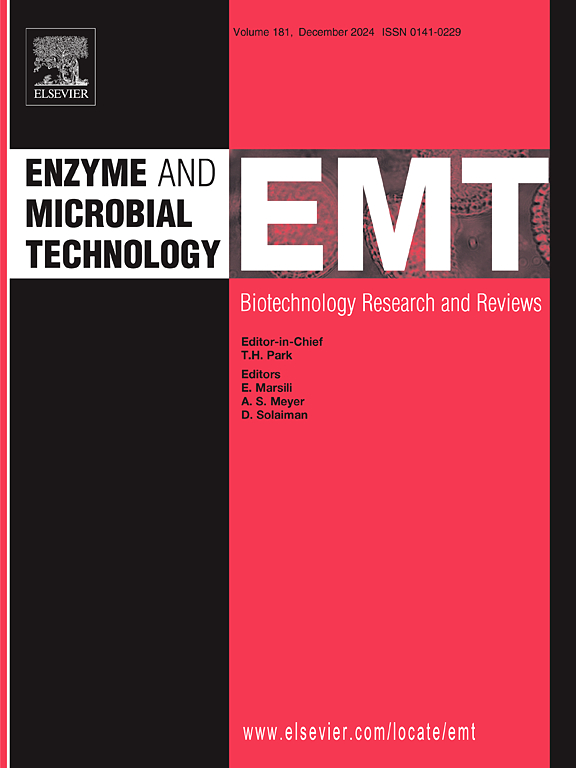Preparation of ginsenoside Rd using a novel α-L-arabinofuranosidase BpAbf51A from Bacillus pumilus
IF 3.7
3区 生物学
Q2 BIOTECHNOLOGY & APPLIED MICROBIOLOGY
引用次数: 0
Abstract
α-L-Arabinofuranosidase has been widely used in the fields of enhancing pasta production quality, fruit juice clarification, enhancing wine flavor, increasing feed utilization rate, and developing special drug ingredients, playing a pivotal role in the food processing, feed, and medical care industries. In this study, a novel α-L-arabinofuranosidase (BpAbf51A), belonging to glycoside hydrolase family 51 (GH51), was cloned from the Bacillus pumilus strain 145 and expressed in Escherichia coli BL21 (DE3), with a molecular weight of approximately 56.0 kDa. BpAbf51A comprises two characteristic domains of the GH51 family: an N-terminal (β/α)8-barrel catalytic domain and a C-terminal jelly-roll domain. The enzyme exhibits high substrate specificity for p-nitrophenyl-α-L-arabinofuranoside and demonstrates optimal catalytic activity at 50°C and pH 8.0, suggesting its potential for industrial applications under moderate conditions. Notably, BpAbf51A specifically hydrolyzes the arabinofuranosyl moiety at the C-20 position of ginsenoside Rc to produce ginsenoside Rd. Molecular docking and two-dimensional interaction diagrams further revealed that the key amino acid residues, Ser213 and Asn214 of BpAbf51A, form strong hydrogen bonds with ginsenoside Rc. In this study, a novel α-L-arabinofuranosidase, BpAbf51A, has demonstrated significant potential for industrial applications in the production of rare saponins and other glycoside-based natural products, providing new research directions for the development of efficient biocatalysts.
利用矮芽孢杆菌α- l -阿拉伯糖糠糖苷酶BpAbf51A制备人参皂苷Rd
α- l -阿拉伯糖葡糖苷酶广泛应用于提高面食品质、澄清果汁、增强葡萄酒风味、提高饲料利用率、开发特殊药物成分等领域,在食品加工、饲料、医疗保健等行业中发挥着举足轻重的作用。本研究从短小芽孢杆菌145菌株中克隆出一种新的α- l -阿拉伯糖葡糖苷酶(BpAbf51A),属于糖苷水解酶51家族(GH51),在大肠杆菌BL21 (DE3)中表达,分子量约为56.0 kDa。BpAbf51A包含GH51家族的两个特征结构域:n端(β/α)8桶催化结构域和c端果冻状结构域。该酶对对硝基苯-α- l-阿拉伯糖醛酸苷具有较高的底物特异性,在50°C和pH 8.0条件下具有最佳的催化活性,表明其在中等条件下具有工业应用潜力。值得注意的是,BpAbf51A特异性水解了人参皂苷Rc C-20位的阿拉伯糖糠基片段,生成人参皂苷Rd。分子对接和二维相互作用图进一步揭示了BpAbf51A的关键氨基酸残基Ser213和Asn214与人参皂苷Rc形成了强氢键。在本研究中,一种新型α- l -阿拉伯糖醛酸苷酶BpAbf51A在稀有皂苷和其他糖苷类天然产物的生产中显示出巨大的工业应用潜力,为高效生物催化剂的开发提供了新的研究方向。
本文章由计算机程序翻译,如有差异,请以英文原文为准。
求助全文
约1分钟内获得全文
求助全文
来源期刊

Enzyme and Microbial Technology
生物-生物工程与应用微生物
CiteScore
7.60
自引率
5.90%
发文量
142
审稿时长
38 days
期刊介绍:
Enzyme and Microbial Technology is an international, peer-reviewed journal publishing original research and reviews, of biotechnological significance and novelty, on basic and applied aspects of the science and technology of processes involving the use of enzymes, micro-organisms, animal cells and plant cells.
We especially encourage submissions on:
Biocatalysis and the use of Directed Evolution in Synthetic Biology and Biotechnology
Biotechnological Production of New Bioactive Molecules, Biomaterials, Biopharmaceuticals, and Biofuels
New Imaging Techniques and Biosensors, especially as applicable to Healthcare and Systems Biology
New Biotechnological Approaches in Genomics, Proteomics and Metabolomics
Metabolic Engineering, Biomolecular Engineering and Nanobiotechnology
Manuscripts which report isolation, purification, immobilization or utilization of organisms or enzymes which are already well-described in the literature are not suitable for publication in EMT, unless their primary purpose is to report significant new findings or approaches which are of broad biotechnological importance. Similarly, manuscripts which report optimization studies on well-established processes are inappropriate. EMT does not accept papers dealing with mathematical modeling unless they report significant, new experimental data.
 求助内容:
求助内容: 应助结果提醒方式:
应助结果提醒方式:


